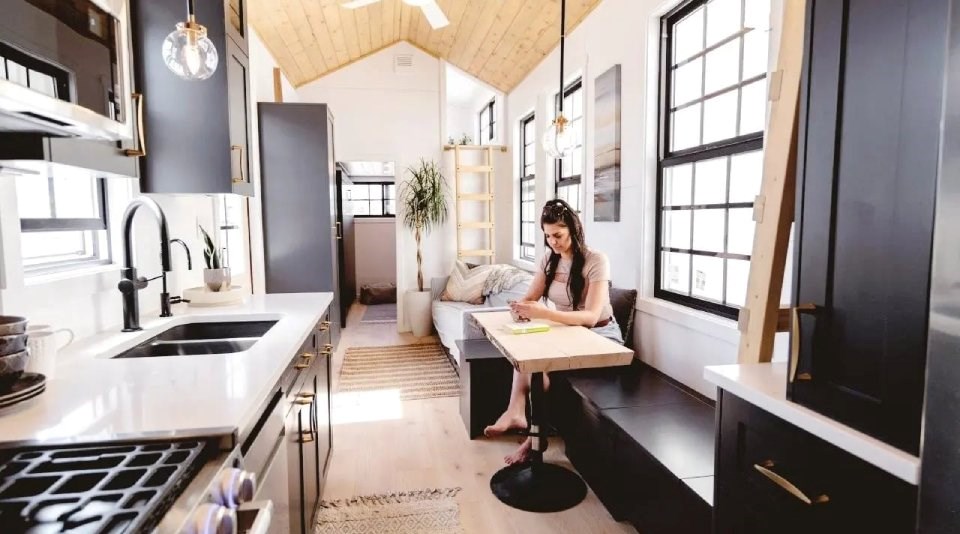A three-year program aimed at analyzing the impact of tiny homes in Northern Ontario is set to begin at Sudbury’s Collège Boréal, and researchers say it could be the first large-scale study on the homes’ potential in the region.
The Natural Sciences and Engineering Research Council of Canada (NSERC) is funding the three-year project, said Sabine Bouchard, Collège Boréal’s manager of applied research, to the tune of $360,000.
“Our project is really kind of there to answer the question — if you want to build a tiny home, what do you need to do?” Bouchard said. “What are the next steps? What kind of design can you use? And what can be done for our region?
“We really want to gather real-world data on the effectiveness of the design as a sustainable, affordable and eco-responsible housing option,” Bouchard said.
Once the Boréal research team has completed their work, the data will serve as a blueprint for other municipalities, Bouchard said.
Currently, tiny homes must comply with Ontario’s Building Code, plus any municipal zoning bylaws and regulations. Those could vary city to city, making the prospect of building or purchasing a pre-made tiny home confusing for buyers.
- Big investment in small homes in Iroquois Falls
- Garden River First Nation gets funding for solar-powered tiny homes
There are also questions about the homes’ durability during long Northern winters, or its carbon footprint as more people opt to live in off-grid communities.
“We really want to develop an Open Access Guide for the city, one that would include some type of construction standards for people who are interested in building tiny homes in our region,” Bouchard said.
“Can we make this home not only affordable, but can it also be eco-responsible?”
The first two years of the study will be devoted to designing and building a tiny home prototype, and in the final year, 2025, the research component kicks into high gear.
At every step, Bouchard said Collège Boréal students — the school is enlisting the help of its carpentry, architecture and design programs — will be applying their knowledge to see if tiny homes can help alleviate some Northern housing issues.
It’s a win-win for both cities and their students.
“Not only do [students] get paid, but they also get to work with some field experts, to get to know some of the industry partners,” Bouchard said. “This can lead to employment for them or internship opportunities afterwards, as well.”
In Sudbury, Mayor Paul Lefebvre said he’s all in favour of making changes to the city’s rules around zoning, saying it will be “all hands on deck” when staff gets around to reconfiguring existing regulations to accommodate more housing.
The city is also partnering with Collège Boréal for the purposes of the study, and Lefebvre said so far, the two parties are on the same page.
“It's very exciting. And I think it deserves our full attention to see what we can do, because I think there's interest,” he said.
“The fact that people don't need these massive homes anymore, if they choose not to. If [the consumer] wants to live a small lifestyle, let’s give them that opportunity.”
Lefebvre said the “key” for making tiny homes and tiny home communities viable in the North will be ensuring that buyers, builders and the city are all playing by the same set of rules.
“If we can standardize this, and there's an interest on the consumer side, and then the developers come to us and say, ‘We need permits to do this’ then we’ve got to be ready.”
Currently, a patchwork of municipal zoning bylaws, plus Ontario’s building code, have made it a challenge, in some areas, for consumers to build tiny homes.
The province has attempted to loosen the reins on building tiny homes in its recent Bill 23, More Homes Built Faster Act. Although critics have pointed out the bill’s potential to create urban sprawl, others have applauded the bill’s amendment to allow up to three residential units per lot.
And if there is enough uptake on tiny homes, expect businesses to start offering more types of customizable houses for consumers.
Pam Robertson, spokesperson for Tiny Home Alliance Canada, said she’s encouraged by the work of Collège Boréal and its attempts to get more cities on board.
But she also cautions people from jumping into the tiny home lifestyle without doing a bit of research beforehand.
“Tiny homes are not for the faint of heart,” said Robertson, who also owns B.C.-based Sunshine Tiny Homes.
“There's a lot to learn.”
Although costs for one of her tiny homes — Sunshine builds average between $127,000 and $195,000 — are well below provincial new home construction averages, Robertson said a custom tiny home could take months, if not years, of prep and planning.
“It’s very similar to a recreational vehicle, which means that you're dealing with propane, you're dealing with plumbing and hookups,” she said.
“There’s a lot to wrap your head around. So if you're going to go into a tiny home, it's good to do your research.”
And as a builder, Robertson said tiny homes have a bright future in Ontario.
“It's pretty interesting, where things are headed,” she said. “I think you’ll just see a lot more of us. There'll be a global standard that can be recognized by anybody within the next year or two.
“My hopes are that it becomes very mainstream, and people have a better understanding about tiny homes,” she said.
